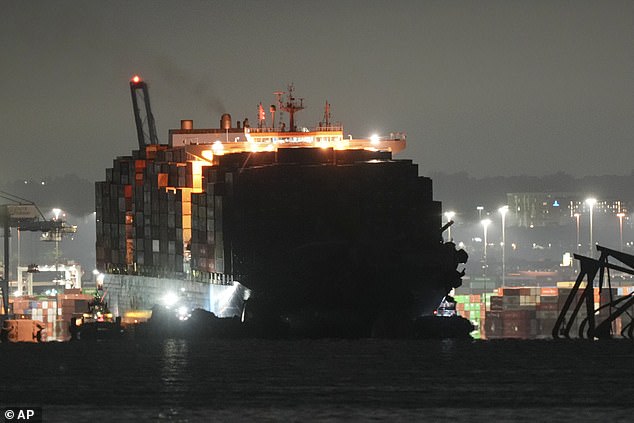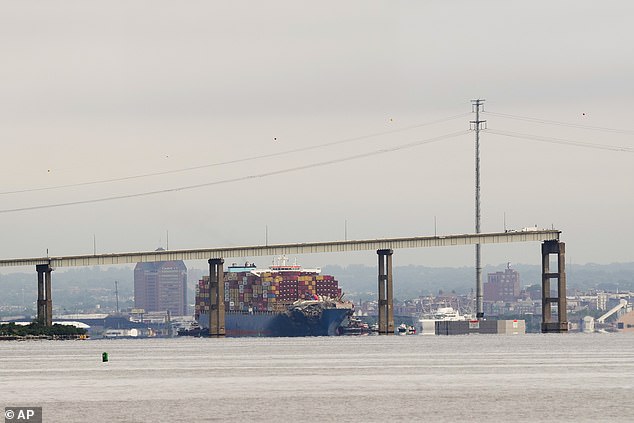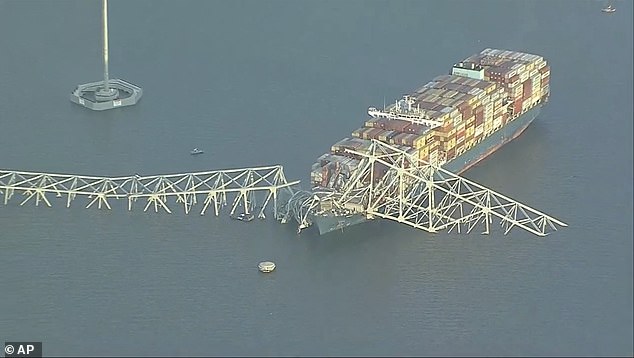- Dalí caused the collapse of the Francis Scott Key Bridge in Baltimore on March 26
- The ship was refloated Monday morning and will be flown back to port.
- The crew has remained on board since the accident, which killed six people.
The container ship that caused the deadly collapse of Baltimore’s Francis Scott Key Bridge is back in port nearly two months after the disaster.
Dali, a 300-meter (984-foot) cargo ship, was refloated during high tide on Monday and began slowly returning to port at a cautious speed of 1 mph, guided by several tugboats.
The ship had been stranded at the collapse site for seven weeks after it lost power and crashed into one of the bridge’s support columns on March 26, killing six construction workers and halting most of the maritime traffic through the busy port of Baltimore.
The crew of 21 has remained aboard the ship since the disaster amid investigations by the National Transportation Safety Board and the FBI.
The ship appeared to begin moving shortly after 6 a.m. as crews began maneuvering to remove it from the wreckage. She started and stopped several times before slowly moving away from the site of the collapse.
Crews work to move the freighter Dali in Baltimore, Monday, May 20, 2024.

Crews work to refloat the Dali in preparation to move the cargo ship during high tide in Baltimore, Monday, May 20, 2024.
Members of the ship’s crew have not been allowed to leave the ship since the disaster. Officials said they have been busy maintaining the ship and assisting investigators. Of the crew members, 20 are from India and one from Sri Lanka.
Authorities have said they will be able to disembark once the Dali is docked in Baltimore.
With the massive freighter removed from the mouth of Baltimore Harbor, a newly opened void appeared on the city’s skyline.
The altered waterscape also highlighted the progress made in the cleanup effort, as crews have already removed hundreds of tons of shattered steel from the collapse site.
A controlled explosion was carried out last week to knock down several massive parts of the wreckage and remove it from the waterway.
Officials said the Dali would be moving at about 1 mph on the roughly 2.5-mile trip back to port, a fraction of the speed it was traveling at when it lost power and toppled the bridge.
Pieces of the bridge’s steel girders protruded from the ship’s bow, which remained covered in concrete shattered by the collapsed road.
Officials have said the Dali will likely remain in port for several weeks and undergo temporary repairs before being moved to a shipyard for more major repairs.
Crews began preparing the ship for refloating about 18 hours before it began moving. That process included dropping anchors and pumping out more than 1 million gallons of water that kept the ship grounded and stable during complex cleanup operations.
Crews carried out a controlled demolition on May 13 to tear down the largest remaining span of the collapsed bridge, which covered the bow of the Dalí.
Dive teams also completed site inspections to confirm there were no obstructions that could impede travel.

Tugboats escort the container ship Dali after it is refloated in Baltimore, Monday, May 20, 2024

The Dali experienced two power outages approximately 10 hours before leaving the port of Baltimore for Sri Lanka on March 26.
The Dali experienced two power outages about 10 hours before leaving the port of Baltimore for Sri Lanka, according to a preliminary report released last week by the National Transportation Safety Board.
The ship experienced two more blackouts as it approached Key Bridge. Those failures caused her to lose propulsion and veer off course at exactly the wrong time.
The FBI also launched a criminal investigation into the circumstances leading up to the crash.
The bodies of six construction workers have been recovered from the underwater wreckage in recent weeks. All of the victims were Latino immigrants who came to the United States in search of job opportunities. They were filling potholes on a night shift when the bridge was destroyed.
Officials plan to reopen the port’s 50-foot (15-meter) deep channel by the end of May. Until then, crews have established a temporary channel that is slightly shallower.


